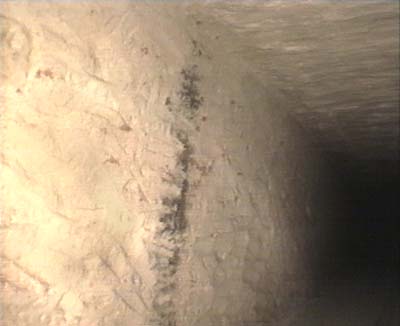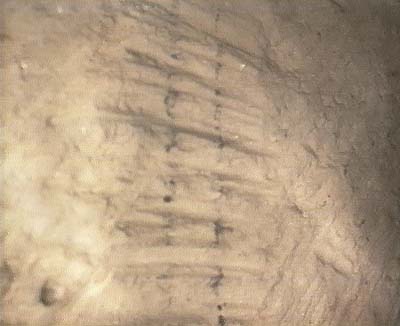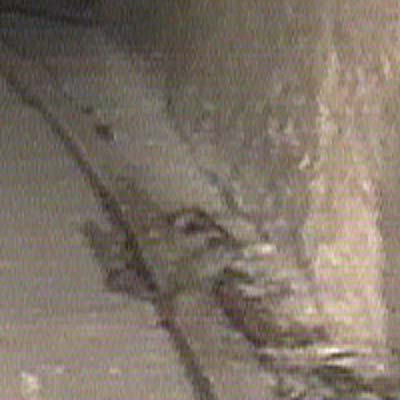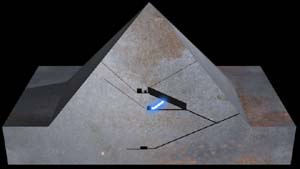To find the position and the related measurements of all numbered blocks,
see the CHEOPS SHAFTS
drawing
at the CYBER DRAWINGS
page.
All
copyrights Rudolf Gantenbrink 1999
After an initial horizontal section of 1.93 meters (penetrating the first block of the Queen's Chamber wall), the shaft bends upwards.
Based on 14 measurements made over a distance of 17 meters, the shaft's angle of ascent fluctuates between 33.3° and 40.1°. Block No. 4 clearly shows that a change in the angle was made at this point. To that end, the builders even cut the shaft 2 cm deep into the beginning of the floor block.
The extreme angle fluctuations and the changes made to Block No. 4 would seem to indicate that, at this point, the ancient Egyptians ran into a conflict with the Great Gallery, which was being constructed at the same time, and thus were unable to adhere exactly to the originally intended shaft angle.
Only further measurements in the still unexplored upper areas of the shaft will tell whether the intended angle is several degrees smaller than that of the southern shaft, or whether both shafts were to be constructed at the same angle, that is, quasi-symmetrically.
Blocks No. 2, 3 and 4 all show signs of minor settling. The first three joints of the shaft are aligned more or less vertically in order to deflect the weight of the roof beams into the horizontal plane.
At the start of Block No. 7 we see the threaded end of a hexagonal iron rod, which was obviously left behind in the more recent past.

The threaded end of the iron rod.
As no "scholar" reports investigating the shaft using such a rod, we can assume it is an artifact of an unsuccessful "treasure hunt," which was supposed to remain secret.
In 1872, Waynman Dixon found and chiseled open the lower ends of the shafts, which had been invisible until then. In his diary and in unpublished letters to Piazzi Smyth (Royal Observatory Edinburgh Archives), Dixon places great importance on the lower shafts and mentions that he was on the verge of a great discovery. After that, the shafts received no further attention, except for angle measurements carried out by Petrie (PETRIE, W.M.F, "Ten years digging in Egypt", New York, s.d.), until 1992.
We can thus assume with some assurance that the iron rod was left behind by Dixon.
Each section of the hexagonal iron rods measures 2.7 meters in length, and is fitted with a round socket, which allows it to be joined to the next section.
In one of the lower shafts Dixon found three objects:
1) a copper "grappling hook" about 5 centimeters long,
2) a small, gray-green stone ball, and
3) a broken-off piece of a square wooden slat or rod, about 13 centimeters long.
Unfortunately, in his writings, Dixon doesn't say in which of the two lower shafts he actually found the objects, but he mentions them in connection with the northern one. Except for the stone ball, the objects are broken fragments. Thus, I assume that Dixon didn't simply find them lying in the horizontal segment of the shaft. Instead, I think that by jabbing the long iron rod into the shaft he broke off the objects, which then slid down to the bottom. This assumption is further supported by finds made at the bend in the shaft, described in detail below.
The "grappling hook" and the ball are now to be found in the British Museum in London. The fragment of the wooden slat no longer exists.

The grappling hook found by Dixon.
The west wall of the shaft, at about the middle of Block No. 8, displays a strange, broad black streak reaching from the floor to the ceiling. The streak is partially interrupted by gouges, mostly perpendicular to the streak, left by a chipping chisel.

The strange black streak on the western wall.
We made an almost identical find at the beginning of Block No. 9, also on the west wall. In this case the streak is not broad, however. Instead, it is made up of two parallel lines, also interrupted by traces of a chipping chisel. But it is also obvious that here the chiseling was done only over the two parallel lines.

The parallel black lines.
The find, at least in terms of the indentation (interruption of the lines by chiseling), is reminiscent of the niches in the Great Gallery. Those niches were closed using exactly fitted stones, to restore the smooth surface of the walls (compare Maragiolio and Rinaldi, "L'Architettura delle Pyramidi Menfiti," Parte IV). Here, too, the intact surface was again "destroyed" by coarse work with a chipping chisel.
In the second third of Block No. 9, between the iron rod and the east wall of the shaft, in an accumulation of dark, undefined material, lies a small rectangular object. The object seems to have two holes drilled in it.

The small rectangular object with two "holes" in it.
Concerning the "grappling hook" he found, Waynman Dixon notes in his diary:
"This thing is bronze green and with strong encrustations agglutivated (sic. Autor's note: agglutinated). Once riveted on to a wooden handle."
The "grappling hook" does indeed have two rivets, but we don't know why. Dixon asserts that it had been attached to a wooden handle. It is possible that on the hook he found traces of wood which have since disappeared. So it remains a matter of speculation whether or not the hook was actually connected to a piece of wood, and if so, what it may have looked like.
But the space between the rivets in the hook does coincide exactly with the space between the holes in the small rectangular object still in the shaft. Thus, the latter could well have been originally attached to the hook.

Move your cursor over the image to fade in the hook.
ALTERNATIVE VIEW
At the end of Block No. 9, the shaft angles about 45° to the West, in order to avoid the static structure of the Great Gallery. It is at this point that Dixon's iron rod, which is bent around the angle, apparently got stuck. Unable to remove it, he seems to have given up his probing of the shaft and then unscrewed the lower section of the rod, which otherwise would have remained protruding from the shaft entrance.
Sticking out of the shaft, at the point where it angles to the West, a square rod lies on the shaft floor, extending to the East wall.

At this point the shaft angles to the West.
Originally we assumed that this was a piece of "Dixon's iron rod," which had broken off at the bend in the shaft. But even then I was surprised that the square rod lay under the hexagonal rod and not over it, as might normally be expected. At that time we didn't yet know that in 1872 Dixon had found a piece of a square wooden slat or rod, about which he noted in his diary:
"Bit of wood, broken off from a larger part, measuring 5 inches, nearby, + accidental (sic) fractured end …"
"Accidental fractured" can only mean that Dixon himself caused the fracture, a supposition additionally supported by the remark "broken off from a larger part."
Dixon probably continued to jab the iron rod up into the shaft until the reported objects slid down to the bottom. In the process he apparently broke off the end of the wooden rod with the hook.
The visible end of the square rod which our robot discovered shows clear signs of having been "fractured." So it seems most probable that the hook was originally attached to a long, square wooden rod, the remains of which still lie in the shaft.
In 1993, Upuaut-2 was not yet capable of negotiating the sharp westward bend of the shaft. Nonetheless, the robot's camera provided us an initial view of the continuing shaft.

A look into the continuing shaft just beyond the bend.
What lies ahead remains a mystery.
We can see that the end of "Dixon's iron rod" is rammed into the right wall. The square rod protrudes a long way into the shaft. At its end there is what seems to be a rectangular structure. Unfortunately, it is so far from the camera that, at this resolution, no further details can be clearly perceived. Only further investigation of this part of the shaft can clarify the situation.
THE UPPER NORTHERN SHAFT THE UPPER SOUTHERN SHAFT THE LOWER SOUTHERN SHAFT
|

